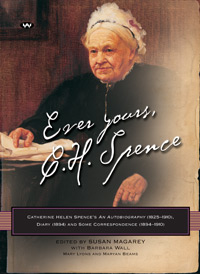
2005, 356 p & notes
The autobiography is a strange beast. Unlike the diary which may or may not have another reader in mind, there is usually an assumption on the part of the writer that someone is going to read it, one day. Although the distinction between autobiography and memoir is fuzzy (see here and here), I tend to see an autobiography as a chronological account, driven by the passing of time, where a memoir is a more consciously created ‘literary’ object, shaped by themes and tropes and where time is elastic.
In this book edited by Spence’s major present-day biographers, Susan Magarey and Barbara Wall, we get autobiography, diary and letters carefully and usefully annotated. Taken together, they build up a vivid picture of the transnational networks that Spence developed and drew upon, confounding our picture of a little old lady in black dress and lace cap.
More than half of the book is devoted to Catherine Helen Spence’s autobiography. It appears to be a good old-fashioned autobiography, starting at the start and ending at the end. But it’s not. Only about 2/3 of it was actually written by Catherine Helen Spence herself. It was always destined for publication in serialized form in the South Australian Register and when Spence died in 1910 she had the first three chapters typeset ready to go, and the following 13 chapters in manuscript. Indeed, she was working on it when she died. Her friend Jeanne Young, a fellow-activist some fifty years Spence’s junior, completed the other eight chapters after some tussling amongst surviving family members. In an attempt to make the change in authorship appear seamless, Young completed the remaining chapters in the first person, drawing on Spence’s diaries and her own knowledge of Spence’s movements from their mutual friendship. It’s not a particularly successful ghostwriting strategy as the autobiography loses its ‘oomph’ as it goes along, and it becomes increasingly bogged down in the campaign for proportional representation, the passion shared by both Spence and Young. It’s true that many people, including Spence herself, said that she was obsessed by proportional representation, but in Young’s hands it dominates the final chapters of the book, unleavened by the reflection and self-deprecation found in the first chapters.
Of course, Susan Magarey and other writers about Catherine Helen Spence have picked the eyes out of the autobiography, as you would expect them to do, and their approaches are easier reading than this autobiography. But it’s good to read an extended length of Spence’s writing to pick up on her clear, but very 19th century narrative voice, and to observe the digressions and asides.
Jeanne Young went on to write her own biography of Spence (which I haven’t read), and in doing so she used the diaries that Catherine Helen Spence had kept every day of her life. However, she refused the entreaties of “Mr Pitt of the Archives” to place them in a public repository, and it seemed that the “diaries had gone out with the newspapers”, once Jeanne Young had finished writing her book (p. 214). However, there was one left -Spence’s diary for 1894- and Magarey (I think – it’s not clear in this book which parts were contributed by Magarey and which by Wall) was able to borrow the diary from the protective and nameless private owners for a week to make notes from it. However, in a letter to the editor of the Australian Book Review in December 2010, following a review of Unbridling the Tongues of Women, Magarey indicated that the State Library of South Australia had been more persuasive than she herself had been, and that the diary was donated to the library and is now transcribed and annotated by Barbara Wall on the Wakefield Press website. [I must confess to not being able to find it there].
The diary covers only the year 1894, when Spence travelled to America, the UK and Europe. There’s an entry for nearly every day, and while they list her rather exhausting activities and meetings, there’s not really a great deal of reflection here.
The volume finishes with a collection of Spence’s letters to two of the feminist activists from this time: Alice Henry, who was to go to America where she was joined by Stella (Miles) Franklin, and Rose Scott from Sydney. These letters are more engaging than the diary, and also reflect the buzz of activity in this indefatigable woman’s mind. They’re also affirming of the network of shared interests that stretched across distance and age to further the causes that people – women and men included- had as their passion.
Source: Readings bookstore (where they have this on special for $9.99 in hardback at the moment. Just do a search on their website)
Read because: I’m preparing for a giving a talk on Catherine Helen Spence at the First Unitarian Universalist of Melbourne Fellowship service this week.
This review has been added to the Australian Women Writers Challenge 2018 database.


I’m hoping to come in to town tomorrow to hear this. My physio was a bit brutal yesterday so it depends on how I’m feeling…
I hope you can- and I hope I don’t disappoint!
Fingers crossed. At the moment I’m permanently attached to a comforting hot wheat bag!
I’ve had this on my shelf five years with vague intentions to read. The story behind the autobiography is fascinating!
Pingback: 2018 Word For Word Non Fiction Festival: Get Real (and an autographed giveaway!) | ANZ LitLovers LitBlog
Pingback: Australian Women Writers Challenge 2018 completed | The Resident Judge of Port Phillip
Pingback: Ever Yours, C. H. Spence, edited by Susan Magarey, with Barbara Wall, Mary Lyons and Maryan Beams | ANZ LitLovers LitBlog
Pingback: (Further thoughts) Ever Yours, C. H. Spence, edited by Susan Magarey, with Barbara Wall, Mary Lyons and Maryan Beams | ANZ LitLovers LitBlog
I’ve finally read this myself!
Pingback: Clara Morison, Catherine Helen Spence | The Australian Legend